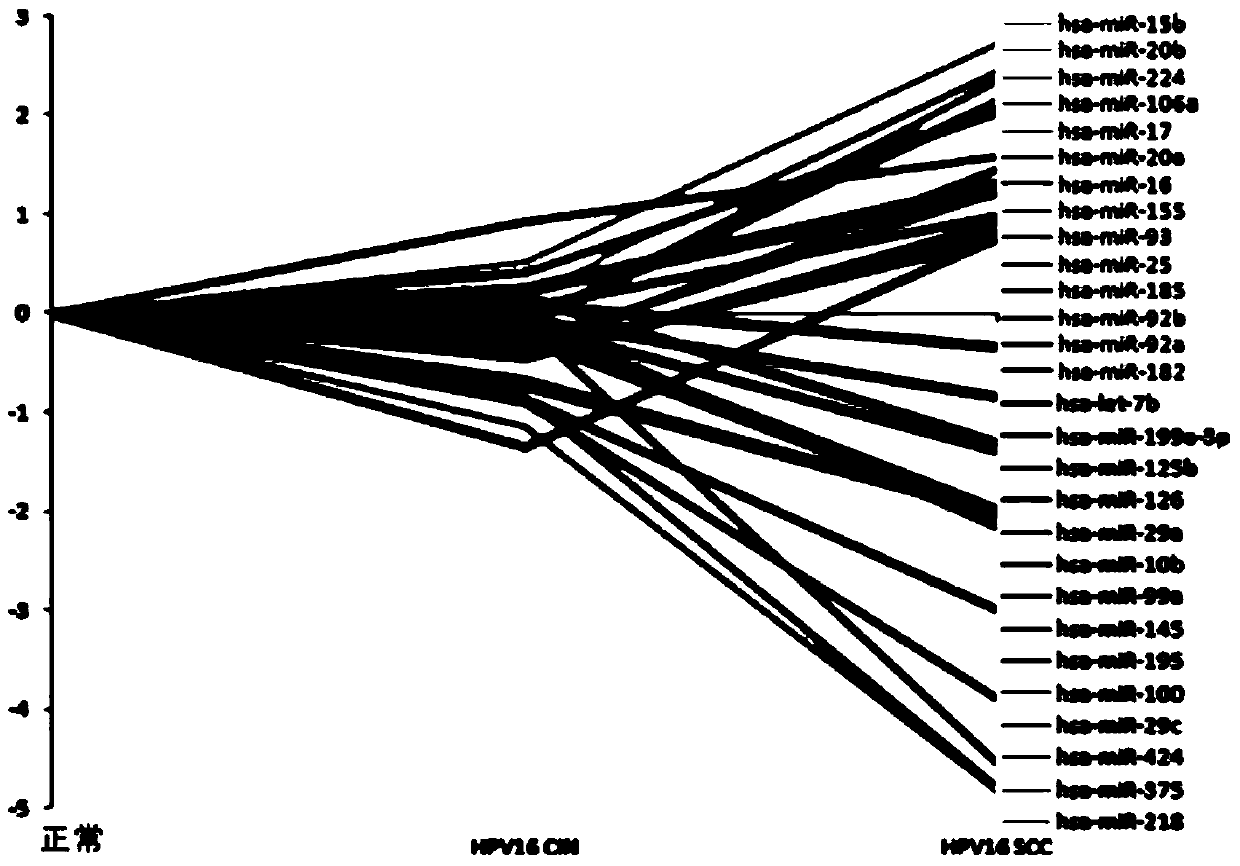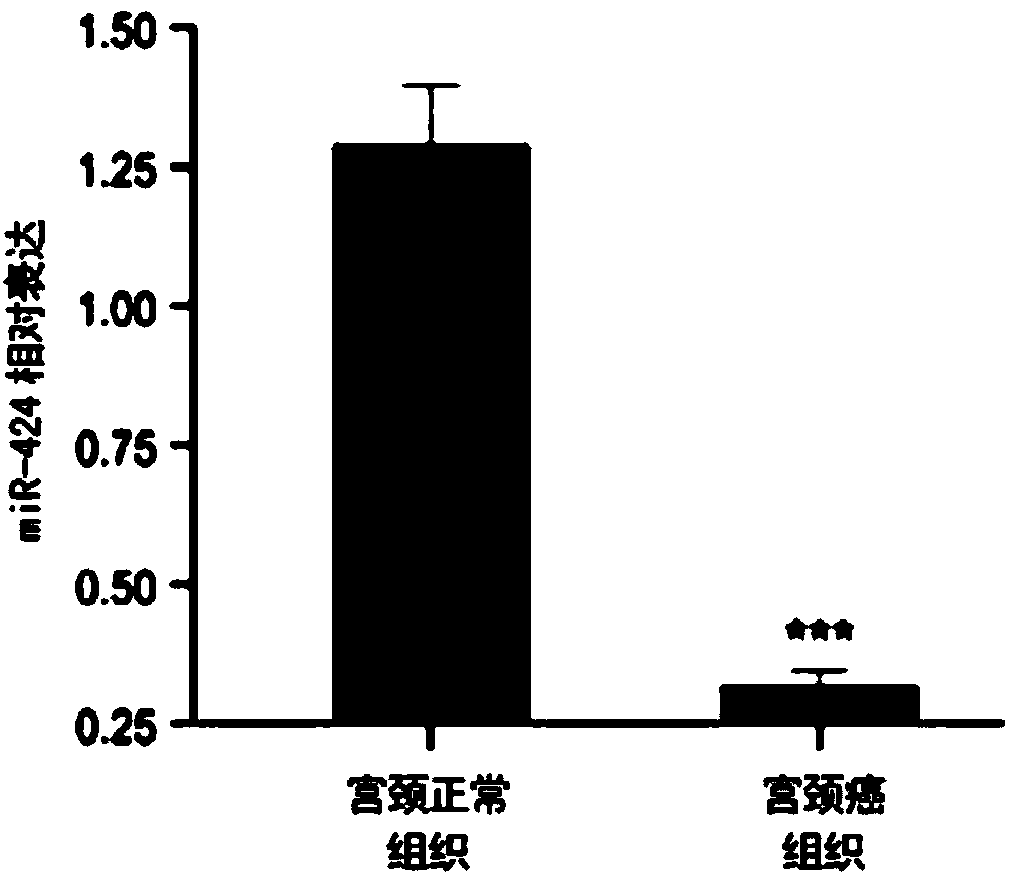Application of microRNA in preparation of kit for diagnosis of cervical carcinoma or precancerous lesions
A technology of precancerous lesions and diagnostic reagents, applied in the field of biomedicine, can solve the problems of few applied researches and low sensitivity
- Summary
- Abstract
- Description
- Claims
- Application Information
AI Technical Summary
Problems solved by technology
Method used
Image
Examples
Embodiment 1
[0105] Example 1, Screening of cervical cancer-related miRNA markers
[0106] 1. Microarray primary screening of miRNA expression differences
[0107] The present invention first uses the miRNA chip to compare and analyze the miRNA expression profiles in cervical exfoliated cells (n=6) with normal histology, high-grade CIN (CIN2-CIN3), and squamous cell carcinoma (SCC) ( figure 1 ). Using ANOVA analysis, from 875 human genome miRNAs (SangermiRBase release13.0), 31 miRNAs with significant expression differences were screened as potential markers for the diagnosis of cervical cancer or its precancerous lesions. Among them, 14 miRNAs (let-7b, miR-145, miR-126, miR-199a, miR-195, miR-29a, miR-375, miR-10b, miR-29c, miR-218, miR-424 , miR-100, miR-125b, miR-99a) were down-regulated in cervical cancer or its precancerous lesions, and 17 miRNAs (miR-155, miR-92a, miR-92b, miR-224, miR-221 , miR-222, miR-31, miR-182, miR-106a, miR-17, miR-20a, miR-20b, miR-15b, miR-16, miR-25, miR-...
Embodiment 2
[0143] Embodiment 2, the preparation of miRNA detection kit
[0144] 1. Kit based on RT-qPCR technology
[0145] In this embodiment, the miRNA detection kit based on nucleic acid amplification includes the following components:
[0146] (1) total RNA extraction reagent: Trizol solution, chloroform, isopropanol, ethanol, DEPC water;
[0147] (2) miRNA reverse transcription reagents: reverse transcriptase, RNase inhibitor, reverse transcription buffer, dNTP mixture.
[0148] (3) miRNA reverse transcription primers: miR-375 reverse transcription primer and miR-424 reverse transcription primer, reverse transcription primer of U6 used as internal reference.
[0149] (4) PCR detection reagents for miRNA: Taq enzyme, Mg 2+ , PCR buffer, dNTP mix, nucleic acid dye.
[0150] (5) miRNA nucleic acid amplification primers: miR-375qPCR upstream primers, miR-424qPCR upstream primers, miRNAqPCR general downstream primers. U6 upstream and downstream primers used as internal reference.
...
Embodiment 3
[0166] Example 3, miRNA detection based on hybrid capture method
[0167] The detection kit for miR-375 or miR-424 was performed using the hybrid capture-based miRNA detection kit prepared in Example 2 above.
[0168] (1) Sample treatment: take clinical samples and mix them with sample lysate (same as in Example 2), and incubate in a 46° C. water bath for 45-60 minutes.
[0169] (2) Nucleic acid hybridization: take out the lysed sample from the water bath and cool to room temperature. Take a 96-well microplate as a hybridization microplate, add the lysed sample and single-stranded DNA probe reagent, and seal the hybridization microplate with a sealing film. Then place the hybridization microplate on a microplate heating shaker, shake at 1100rpm for 3-5 minutes, and mix well. Incubate at 46°C for 60 minutes, then remove the hybridization microplate and cool to room temperature. The presence of miR-375 or miR-424 in the sample will combine with the single-stranded DNA probe t...
PUM
 Login to View More
Login to View More Abstract
Description
Claims
Application Information
 Login to View More
Login to View More - R&D
- Intellectual Property
- Life Sciences
- Materials
- Tech Scout
- Unparalleled Data Quality
- Higher Quality Content
- 60% Fewer Hallucinations
Browse by: Latest US Patents, China's latest patents, Technical Efficacy Thesaurus, Application Domain, Technology Topic, Popular Technical Reports.
© 2025 PatSnap. All rights reserved.Legal|Privacy policy|Modern Slavery Act Transparency Statement|Sitemap|About US| Contact US: help@patsnap.com



